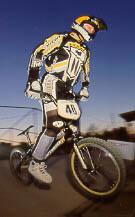 We tracked
down Racing Legend Harry Leary, not that it's that hard these days, and
had a chat with him about family life, music, racing, training and Dirtwerx.
We tracked
down Racing Legend Harry Leary, not that it's that hard these days, and
had a chat with him about family life, music, racing, training and Dirtwerx.
At 41 years of age Harry is still competitive at a Pro level after 4 decades
of racing and he still has the passion he had for the sport when he first
stepped foot on a track.
Once this interview got started it looked like never coming to an end,
there were so many questions to ask Harry and he had so many answers,
read on and maybe we'll do a part 2 to this interview.
bmxultra.com: How did you get involved in BMX? Where and when?
Harry: I remember that it was when I was about eleven or for a better
reference in 1970, it was then that I started to ride a20” bike for more
than just going to a friends house. I started to jump stuff, see how far
I could wheel you know the basic stuff. Things started to get fun, but
the bad thing was I started breaking things on the bike. My Grandfather
was a welder (arc) so I would have him fix and beef up the areas thatwould break, now that they would not break I could go jump bigger stuff!
It was in 1973 that I was at the local bike shop and noticed a flyer for
this bike race, they were going to have jumps, it was in the dirt and
they were going to have a mud hole, cool! So that was my first race and
I got first, from that day all I wanted to do was compete. For the record,
I had to work and buy every single part I ever raced on up until I got
a factory sponsor.
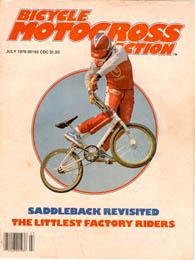 bmxultra.com: Tell us a little bit about Dirtwerx. How did it come about?
When?
bmxultra.com: Tell us a little bit about Dirtwerx. How did it come about?
When?
Harry: Dirtwerx at this time is a race driven company. We do most of our
marketing through racing, and some advertising. I started Dirtwerx after
Balance went upside down. Balance was a great learning experience for
me. I was the general manager there and it gave me the opportunity to
run and manage a large company, to see things that I did not get to see
while at Diamond Back. So I thought that it was time to start doing it
for myself, for 20 years I had been beating myself up on the track for
the promotion of someone else’s bottom line. We basically started out
in 1996 but only after some major convincing by some family (Mom, Wife)
and friends (Greg Hill). I cant yet say it was the best thing I ever did,
I was making good money at Balance and I think of where I might be financially
if I were still collecting a check like that every month. But in life
we are taught that we must look at the long-term plan, so we are still
going, and going, and going...
bmxultra.com: How did you come up with the name?
Harry: It was a combination off things that I really enjoy. The first
is that, to me there is nothing like riding in the dirt, its always changing,
your always having to make adjustments to the changing terrene and conditions,
its sort of like business and life. "Works" is the word that started in
motocross, which is used for when referring to the trick racing equipment
that factory-racing teams only get to run. I wanted to change the way
the word looked in type, to have the same number of letters as "Dirt".
This way the logo would be balanced. Making it one word was the idea of
Sergio of "Smith, Smith & Smith (they are a design and marketing firm
that I used while I was at both DiamondBack and Balance, he/they are the
best at what he/they does). There you have it "Dirtwerx"!
bmxultra.com: Once you had the name how hard was it to design the logo,
frame stickers and the Jersey?
Harry: I worked with Sergio to get all that done. It was a time consuming
process, I don't think people really realize how hard it is to get something
that looks good, says something in the way it looks and is easily remembered.
The worst part of the whole thing is that is just like art, its subject
to opinion. Not everybody thinks that "Picasso" painted great paintings,
some people like and some don't. The important thing is that it represents
who you are, in this case, it’s who I am.
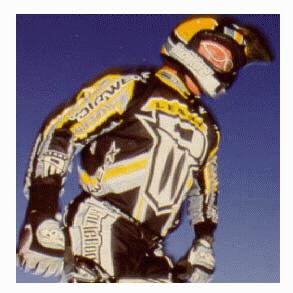 bmxultra.com: What do you produce?
bmxultra.com: What do you produce?
Harry: We produce high quality (doesn’t everybody) Chromoly frame, forks
and handle bars. Our frames come in nine sizes. Mini, Jr, Expert, Expert
XL, Pro, Pro XL, XXL-Stilt, 24-XL and 24-XXL Stilt. We only use Chromoly
and there are many reasons for this. The main one is you can build a better
bike using steel. A bike that has some really cool ride characteristics,
things you can not get out of alloy. Not only that, alloy has a shorter
life. There is no way an alloy bike will last as long as a steel bike,
I do not want to have to replace bikes. Now you can build a flashier bike
with alloy and maybe a better race bike. If your factory sponsored and
can get a new one every three months then and only then alloy could be
better. For the real world where most of us reside, "steel is real". Also
when it is all said and done the two frames will be almost be the same
weight, at least within a 1/2 pound. If people were really worried about
weight they should train more and get rid of some of those extra inches
around the waist, I’m sure we all have a couple of extra pounds we could
do with out. We have many new ideas on the drawing board but cash flow
determines what we can do, so they wait until its time.
bmxultra.com: Are you exporting? How many Countries?
Harry: We export to five countries now. It’s not a big part of what we
do. But we are always looking for more.
bmxultra.com: Which countries?
Harry: Japan, France, Mexico, Brazil and Singapore
bmxultra.com: If not do you expect to in the future?
Harry: We need to focus on the USA, that’s were the money is. We will
expand as it comes.
bmxultra.com: how difficult is it to break into the BMX frame manufacturing
scene in the US?
Harry: Its very difficult, right now there are 42 frame makers out there,
give or take. It takes commitment from the company trying to bust their
way in. Riders, parents, dealers will not buy into a non commited program.
We are doing the best that we can with what we have to work with. It takes
a lot of money to do it quickly, so we are doing it at our on pace.
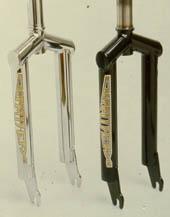 bmxultra.com: The forks look like they have long dropouts, what is the advantage
with these forks?
bmxultra.com: The forks look like they have long dropouts, what is the advantage
with these forks?
Harry: Yaw, they do have long dropouts. This was so I could keep the fork
as narrow as possible; the hub flange would not clear the fork leg if
the drop out were shorter. I could have made the fork wider, but I wanted
a narrow look while your sitting on the bike and looking down at the fork.
The advantage is that I can make the wall thickness of the tubing what
they need to be. A standard fork has to start out with a much thicker
wall because they have to bend the fork leg in to the steerer tube. The
bending process stretches or thins the wall thickness of the tube. That
is why they have to start with thicker or heavier tubing than my forks.
My fork has three different wall thicknesses, the legs, the stanchion
tubes and the steerer.
bmxultra.com: Do the dropouts flex much?
Harry: The dropouts do not flex, I made them out of 4130 plate, and they
cost me $3.00 each. I would bet that most other forks are high-tensile
steel that would be a problem with my fork design. Now for street riding
with a peg up there, then yes, I would say you would get some flex. But
for riding trails and going racing on, you will bend or break them and
walk away from it.
bmxultra.com: What made you come up with a chain tensioner? Wouldn’t it
be better to just tighten the chain?
Harry: Actually I saw that on Danny Nelson's bike many years ago (he still
uses his own version of the same thing), and I thought that was one of
the simplest and yet most functional things in years. If you’re strong
and you race your bike will flex out of the gate. You want a little flex.
Under acceleration the chain will get loose on the bottom side, so this
is when your chain can catch the side of a tooth on the freewheel and
come off. The "Painkiller" will not let the chain flex from side to side
so there is no way it can catch the side of a tooth. To keep your chain
in perfect tension while under acceleration it would be way to tight,
and you would have no free backspin with your cranks.
bmxultra.com: Where can people buy your products?
Harry: Dan`s, bike shops across the States, from Dirtwerx directly.
bmxultra.com: What sort of a commitment does it take to set up your own
business?
Harry: More than I know at this point, I have yet to totally commit to
it. I still put to much time in to my riding, I need to change that. It's
a hard thing for me to give up, I love it too much. I think I need to
hire somebody to run it so I can still ride, that’s a stupid idea! Every
waking (and I think sleeping) moment of everyday is spent thinking about
the business...how should I do this...when should I do that...was that
the right thing to do. I need to start looking for a pro rider…that will
take forever. So if there is a word that is beyond commitment that’s what
it is!
bmxultra.com: Australia has no (or a very small) BMX industry…we rely on
the US and Asia to produce quality bikes and accessories, which is good
and bad. Good because these guys have spent years in building and designing
BMX bikes and accessories, and bad in the case of the US because our exchange
rate is screwed. We have to pay a load of money to get a quality bike,
which can make the outsider think that BMX is expensive. Do you think
it can make a difference to the local scene if a country has it’s own
industry?
Harry: Imagine for a minute you’re a parent with 2.5 kids (that’s the
US average) one of those wants to start racing, one wants to be a golfer
and the half a kid has not made up his mind yet. So you head to the bike
shop and shop for a bike and gear for little Johny. Parent goes in to
sticker shock, and walks over to the sporting goods store and buys a football
(Aussie style). Now that parent might have walked out with a happy Johny
had there been a local brand to support. I guess we are spoiled over here
in regards to that.
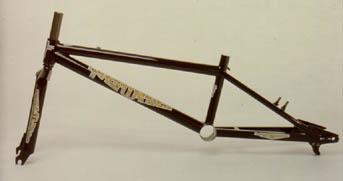 bmxultra.com: You keep in touch with Greg? Tell us about how you first met
him.
bmxultra.com: You keep in touch with Greg? Tell us about how you first met
him.
Harry: Yeah, Greg and I still hang out once in a while, but more lately
only at the races. The first time I saw Greg was at a track called Western
Sports Arama (The Track Out Back) as it was known. He was maybe 11-12,
and a real pain in the ass! You would be sitting on the side of the track
waiting to do a lap and he would come by and jack with you so you would
chase him around the track. I am sure that all that chasing added to his
already strong fast twitch muscle fibres. It was almost impossible to
catch him! Actually that is how I came up with the "Leary" jump. There
was this table top down the front straight, and he would be sitting on
the side (waiting to do a lap)…so I would go up the jump in the middle
and whip the back wheel out to try and hit his helmet/visor. It was a
way of sneaking up on him, and it just progressed from there.
bmxultra.com: How often do you see each other these days? Do you think your
kids will get along?
Harry: We do not see each other as much as we did. Greg and I are a lot
alike, we are very intense and that seems to make getting along kind of
tuff. Greg is a great person and I really respect what he has done, and
is doing. It’s that we seem to be so wrapped up in our families and our
businesses that there is no real time to communicate. Greg is much deeper
in to the family thing than I am. We just recently had a baby girl (Jan.
10 2000) her name is Breyana Nicole. Greg has a little boy Jeramy, I think
he is three going on four. So the two young’ns have not hung out yet,
but I am sure they will...and no, there no wedding plans! The Hill`s as
in-laws? I think not! (Kidding!)
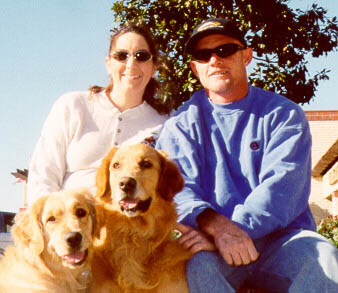 bmxultra.com:
Will Breyana race?
bmxultra.com:
Will Breyana race?
Harry: If Breyana wants, Breyana will. I hope that she will give it a
try some day. I plan on teaching her how to ride a bike very early, I
hope by three. I don`t know how many others notice, but the kids that
ride BMX at any level at an early age seem to be way ahead of kids (of
the same age) that do not. I mean, I see 5-6 year olds that can jump some
little doubles, crash slap the ground hard and jump up head back the gate
and do it again. Then you look at the average 5-6 year old who has not
been exposed to that and they seem to be way behind the development process.
I guess that’s why BMX is such a cool sport, because it’s not easy.
bmxultra.com: Are there others you used to race with that you keep in touch
with? What about Eric Rupe?
Harry: I still see and talk to a lot of the originals! Clint Miller, Eddy
King, Stu Thompson, Pistol Pete Loncarivich, some of the East Coast guys
as well, so over the years we all have shared a lot of time together.
Rupe practices at the same track as I do, or I at the same track as he.
He sure is fast for his age! We are racing in the ABA vet pro class together
now and he pretty much kicks everybody’s ass! He has a very strong race
program and it shows every time he is on the track, you only beat him
when he makes a mistake, and that’s not often enough! I wish I was eight
years younger, I might have something for him!
bmxultra.com: what makes DirtWerx different to any other manufacturer?
Harry: On the surface, not a lot. But, looking at what should be considered
when buying a bike there is a lot more. Our forks for example, are not
an over built boat anchor just to make them strong enough to with stand
today’s riders needs. The design is the strongest and lightest out there.
The other over looked feature of today’s bikes is the way they ride. I
have many years of designing, and of course, racing bikes that I know
what works, and where it should work best. So I have tried to put more
importance on the ride of the bike than most of the other companies. That`s
what is important to me, what kind of lap am I going to get out the bike.
How can I make the bike gate better, turn better, jump better, only with
years of riding different bikes can anyone really know good from bad,
or better from worse. That’s the one thing I always tell people shopping
for bikes, before you buy, know what you like. Educate yourself before
you layout the cash. Don`t buy because you like someone’s nose ring, or
tattoo. I can go to a track and sit and look at all the riders and I would
asy that 40% are riding the wrong bike for them. I am not saying mine
would be the right one, but had they educated themselves during their
purchasing process they would have not ended up with the bike they got.
Our frames also come with a "Painkiller Chain Guide System", this just
ensures the chain will never come off the freewheel, it only rubs on the
chain when its doing its job, keeping the rider from going over the bars.
They also come with chain tensioners, right and left. Also a three inch
head tube, this allows for more bar height adjustment. You see a lot of
riders on a 20" with their stems set upside down just to get their bars
lower. The shorter head tube allows this and it also gives a better leverage
angle on the bike. This sport is all about leverage, it’s your body getting
the most out of itself through the bike you’re riding. If your bike is
set up all wrong or the geometries don’t match your needs, you're wasting
effort, which translates into speed, or the lack of. So think about this
kind of stuff before you buy the next bike or, to adjust the bike you’re
riding now.
bmxultra.com: So it’s not enough to say ‘well I’m a tall rider, let’s see
what other tall riders are using’?
Harry: That`s a good place to start, but what if that rider is not riding
the correct for him. If the rider is a tall pro, there is a real good
chance that he is not riding a stock bike and if he is, is it correct
for him. If you have the opportunity to ask the pro what he is riding
do it! Find out the key dimensions, top tube length, rear center, BB height
and angles.
bmxultra.com: How do you sponsor?
Harry: When I was starting out in the sport I was very lucky to get hooked
up with Jim Melton from JMC. He took a lot of pride in his race team and
made it a point to make sure every one could get to the races that he
was going to. To this day I would have not been the rider I am/was if
it were not for Jim. So with that said, I really enjoy having the race
team. It is giving me a chance to help and train younger riders that show
that same desire that I had early on. I must be honest, I want nothing
to with the want-a-be riders out there. What I mean by that is the riders
who are riding and racing because that is what their parents want them
to do, it's not what the kid truly wants. This sport is from the heart.
the riders heart, not the parents. I do not look for kids who are already
winning like the big factories do. There are some talented kids out there
right now, they may not race good yet but they have the desires to improve.
The "Arndt" family is the perfect example of that, they are the most dedicated
group of kids that I have ever seen. Their parents Brian & Cindy came
to me about 4 years ago now and wanted me to start training the 3 boys
and daughter, I did, and have been now every Thursday for the last four
years. I do not think they have ever called and said we can not make it
today. This family is amazing and I am proud that they are wearing the
"Dirtwerx" jersey, Thank You Brian, Cindy, Bryan, Brock, Brandon and little
Miss Brooklyn. My entire team consists of riders from one track, Simi
Valley (Sycamore BMX) this track is owned and operated by two of the coolest
people around, Joan and Tony Nigro. I want riders I can work with every
time I’m at the track. We really only race here in the western states
so I do not need riders all over the Nation. I am so lucky to have the
riders I do. What is cool is that more and more families are racing together.
Six riders are from two families: Ashley (8 girls) & Chris Verhagan (30-35
Cruiser), Brooklyn (9 girls), Brandon (11 ex), Brock(12 ex) & Bryan Arndt
(14 ex), Seth Hall (16ex), Sierra Lininburger (16 girls), Carrie Blancard
(36-40 girls cruiser) and Joan Nigro (45 & over girls cruiser). As you
can see I have a very wide range of riders, it werx for us!
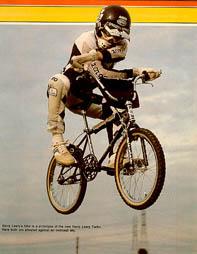 bmxultra.com: Do you often have people asking you for a sponsorship? What
do you say to them?
bmxultra.com: Do you often have people asking you for a sponsorship? What
do you say to them?
Harry: I do, and I am just honest. I tell them, “right now I am very happy
with the team I have”. I also would need to get to know them and their
parents before I would ever consider them as a rider. Most of the time
it’s better to start with great parents than a great rider. A coach and
great parents can make a great rider. It’s a longer process, but a lot
more fun and rewarding for everybody involved to do it that way.
bmxultra.com: Did your parents coach and support you when you started out?
Harry: You know my parents really had nothing to do with my BMX racing.
I take that back…when I was eleven and started to ride a 20" bike with
BMX intentions (wheelies, curb jumping). My dad would not allow me to
ride in the street, but while my dad was at work my mom would let me ride
in the street and set up jumps and ride with the other kids. I just had
to make sure I was in the yard before my dad got home. I think my dad
has seen two of my races in the 28 years I have been racing. My mom has
seen more, but not many more. What I did I did on my own. I worked and
paid for all my parts (until I got a factory sponsor in 1980), I found
my way to the races. When I was on JMC Jim would take the team to the
races in the JMC van, the thing was you had to meet at the shop, which
was about six miles from my house. So I would ride there before the races
with my helmet bag, tools, and whatever else I needed, and after the races
I would ride home, sometimes like at 11:00 at night. I did this for a
long time, that’s how important racing was to me. I think that’s why today
I still am doing what I am doing, it’s a love for the sport.
bmxultra.com: Who are your current sponsors?
Harry: Dirtwerx, Knucklebone, AXO, Sycamore BMX
bmxultra.com: What is your proudest moment in BMX?
Harry: Every time I get in the gate! Murray World Cup 1982! All 25 cover
shots! Respect from other riders and parents, watching the Arndt kids
race. Teaching a rider how to get out the gate first and seeing his face
after he gets his first holeshot! Being in the BMX Hall of Fames, ABA
& IBMXF.
bmxultra.com: How many titles have you won? World championships, ABA, NBL
etc?
Harry: You know what is funny about titles, over the course of time no
one remembers who won what. The only way they do is if you keep reminding
them how many races you won, how many championships you won, it's all
crap. I have two number one ABA Pro Master Titles. I have six National
Number Two Pro plates. I have a Bronze Medal in the 1984 World BMX Championships.
I am in two BMX Hall of Fames. I have a Silver Medal from the 1989 Mountain
Bike World Championships in Dual Slalom. I have a Bronze Medal from the
1990 Mountain Bike World Championships in Dual Slalom, and I think I have
more cover shots than any other active racer. What does that crap mean
now, nothing! It’s what I was, it’s what I am now and what I am going
to be, that matters to me now. For the record, would not change a thing!!
bmxultra.com: What about the MTB racing, did you enjoy it? How does it compare
to BMX?
Harry: MTB racing was fun, it had its drawbacks just as I am sure BMX
does. Slalom was cool, but everything else about mountain bike racing
sucked. Downhill racing was won on when you got to go down the mountain.
If your got an early run the corse was still fresh, you go later and it's
all cut up, it was hard to see that as fair. Cross country was a joke,
I love the physical challenge that it represents but to start in the tenth
row behind sixty guys does not seem like a fair way to have a chance at
winning. I guess I am spoiled with BMX. Eight guys line up dead even,
and nine times out of ten the fastest guy will win, that’s the right way.
I should have made the move over to mountain bikes...could have made a
lot more money over there. But my heart was with BMX and that’s more important
to me!
 bmxultra.com: How many of your cover shots were doing the “Leary” Signature
jump?
bmxultra.com: How many of your cover shots were doing the “Leary” Signature
jump?
Harry: Five maybe six
bmxultra.com: How many countries have you raced in and what is your favourite?
Harry: I think, seven. France was the best! The crowds and racing at Bercy
were the best! Then of course, good ol-USofA.
bmxultra.com: What do you think of the number of International riders in
the US now?
Harry: Not enough, I think every rider that races BMX outside the USA
should get a chance to race here. This is where it happens, this were
everyone reads about. There needs to better system to bring the best riders
from around the world together to race. I know the NBL and UCI try, but
that’s not as good as it could be. I don’t know of a better way, but I
am sure that one could be put together. I am sure that it would involve
spending a little more cash, but I think that that would only be investing
in the future of the sport and it's world wide marketability. Let's face
it, the demographics of BMX are perfect for world wide corporate involvement,
it’s time.
bmxultra.com: The unfortunate thing about Australian riders going to the
US, is that most of them get to a certain level here and then they head
to the US for good. Leaving riders behind who could benefit from competing
against them, I guess it’s a distance thing and a cost thing, the Europeans
should consider themselves very lucky. I guess there is the benefit of
the turn over of pros and the new faces making finals, etc. Do you think
there is a benefit to countries out side of the US that all the top riders
are going there to compete?
Harry: I think you make a valid point, new faces, new goals for those
riders would be a good thing. Now is all that good for the bike business
in those countries? Whenever I here of situations like this I try and
put myself in them. If I lived in another country and saw all the good
pros going to the USA and making good money, then I would do what ever
it took to do the same thing. I think that that would be very motivating
for the up and coming riders to use as a goal. I think that this concept
would have to trickle down in to the younger age groups, which should
help riders focus and improve so they can move on. Over here you can look
at the older amateurs and pretty tell who will be a good pro and who will
not, and there are a lot more will nots than wills! This is totally based
on the depth of the AA class and has no regard to their abilities on the
track, well maybe a little.
bmxultra.com: Would you say it has helped the sport grow internationally
or do you think it would have grown without it?
Harry: I think that anything that is positive will have a wide spread
positive effect. It has been the best thing for American BMX to have the
influx of international riders. It has changed the sport of BMX. One guy
had that effect, Leveque. He forever changed how a rider will attack a
set of triples, or a rhythm section, or power down the first straight.
It’s up to the American riders to respond, learn and get it back together,
so far?
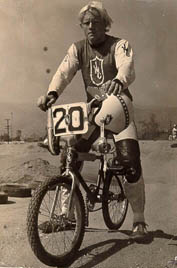 bmxultra.com:
What Music do you listen to?
bmxultra.com:
What Music do you listen to?
Harry: Anything but Garth Brooks, no I`m kidding. There is so much great
music out there, I really enjoy music. Music lets me really think about
things, so depending on my moods, thats what I listen to. From Boston/Fore
Play, Long Time, to Kid Rock/Cowboy and Metallica, it’s all good! Oh ya,
can`t leave out "The Mighty Zep", they have a song for every mood!
bmxultra.com: What do you think of Neil Young?
Harry: As long as I don`t have to look at him! It’s a mood thing! Rust
Never Sleeps is a great song. I have never paid money to listen to him,
so there you have it.
bmxultra.com: When I think of Harry Leary I think of you doing your signature
jump in the old diamond back gear. What was it like racing as a pro back
then, was there enough money so you didn’t have to work? Were there all
the contingencies, bonuses, etc that there are today?
Harry: Racing pro then is like racing pro now. Each rider has a responsibility
to his sponsor to be prepared to race, do the best job he can on the track,
and handle himself in a pro kind of manner off the track. I feel I did
a good job of doing all of those things. You can't always be a super pro,
there are sometimes when tempers get out of hand and you need to straighten
somebody out, we are racing for money and this is not tennis. I think
people forget that it’s for money, it’s serious. I took my racing very
seriously then, and I still do now. There was enough money for the guys
who were doing the job, just like now. Top eight guys now do well, and
the top eight guys then did ok. Money is better now, and it should be,
these guys do a great job for the sport and should get paid well. Contracts
are kind of the same now, I always tried to be very creative with my contracts,
I think you need to be. There are many ways to make money from your sponsors
that is a win-win situation. Your contract is one of your motivators,
I always structured mine to motivate me. I got paid to win, to get coverage
in the magazines, to do in store (bike shop appearances), to go on the
road with the Diamond Back sales reps, to develop new products. The co-sponsors
also paid money, for all of the same things! It always made me laugh when
I heard riders talking about how much they made and that they made more
than this guy or that guy, it was all wishful thinking on their part,
hoping they were making more! There is a lot more to being a top BMX pro
than going fast on the track and winning, riders lose sight of that real
quickly. Being a pro is not just about wining championships, its about
selling product for your sponsor! I made sure I did that for mine!
bmxultra.com: Do you think that’s why pros like Fuzzy Hall, Todd Lyons and
Charles Townsend now have their own websites? So they can help spread
the word of their sponsors even further than printed media?
Harry: Heck ya! It’s the future! Pros want to make more money then they
should do something that raises their value, get creative! I hear pros
complaining about the purses that the sanctions put up. Well here is a
free suggestion, The pro’s should get together and form a "Professional
Marketing Corporation" (or whatever you want to name it). Present to the
sanctions a marketing plan that they will do (with the help of their sponsors
because they will benefit from this as well) to bring more riders to the
races (Nationals). Going in to an area where there is going to be a National
race that weekend and do some local promoting for the race for the sanctions,
Radio, in school, parks and recreations, bike shops. The duties would
be rotated so that it is not always be the same riders. Because it would
effect your racing if you had to leave two days early all the time, so
by rotating this would not be a problem. I am sure this is not the answer,
but the concept is. Selling product for everybody. Right now the BMX pie
is only so big, and everybody has their share and all we are really doing
is steeling shares from each other, as and industry we should work to
make the pie bigger!
bmxultra.com: What’s it like racing these days? Do you still have old fans
come up and ask for autographs?
Harry: Racing today is very tough, I am racing young guys with young legs
and they do not have a lot of crashes on their bodies yet, so they are
brave. I have old legs and lots of crashes, but its great, I love it!
It takes a lot of training/time to keep up with these young guys, that’s
the one thing older people do not have a lot of, time. Work, families,
Motocross racing, boating, so many things to do! I hope (God willing)
I can continue to compete in BMX for a loooooooong time to come! I have
both old and new fans, it's great. But I need to give a lot of the thanks
to the announcers at the Nationals, guys like, Mike Redman, Ray Rome.
When I am on the track these guys really do me right on the mic. Also
the ABA`s BMXer Magazine, they always print some nice things about me.
With out them, it would just be laps on the track.
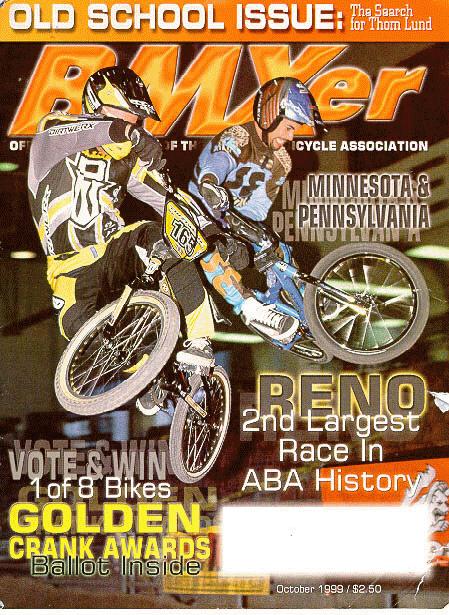 bmxultra.com: Do you think the newer generation of BMXer respect the old schoolers?
bmxultra.com: Do you think the newer generation of BMXer respect the old schoolers?
Harry: No! I do not think they need to. We did what we did and that’s
over, it's their turn to pave the road for who is coming up. I want to
be part of the new school, I don`t want to be sitting in the bleachers,
bench racing on how good it was then, or who won the most races back then,
who cares? How many kids out there enjoy their History class at school,
I know I never did. It’s about today, and what we are going to do tomorrow.
I hate that term "old school", I think old school is for the guys who
used to race 15 years ago and come back today and race with the same style
as they did 15 years ago. I think everybody would still be riding like
old schoolers if it were not for guys like Christophe Leveque. His skills
have changed the direction of the sport, that’s amazing! If you watch
the top riders in every class they all have adapted that riding style,
just like him, awesome!
bmxultra.com: I don’t think there is any disrespect meant when people call
you old school, heck I have been racing continuously since 1981. I get
called old school all the time, doesn’t mean I’m fat and trying to hang
on to my past…I’m doing better now than I have in a long time…I think
it’s more a respect thing, to an extent. It’s really just a term for someone
who’s been there a while. How could you hate that?
Harry: Man, you have been racing for a long time, wow, you are old school!
That’s kind of my point, I bet that you don`t ride like "old school",
I am sure you have progressed with your skills right along with the movement
of the sport, I hope! From one "old schooler" to another I think is ok.
But here it seems to be used more in the negative context. It's just one
of those things that bugs me, I guess, I should just get over it.
bmxultra.com: Unfortunately I have suffered because of our state organisation.
If someone builds a technical track they usually get asked to tame it
down for the safety of the riders. This was evident at the ’98 world championships,
not that the track was great but it was technical, far more technical
than any track in the same state as the worlds were held, naturally a
lot of the locals failed to transfer. I am moving slowly out of my old
school racing style, some jumps still scare me. How important do you think
it is that riders are allowed to race on technical tracks?
Harry: Some jumps scare me as well, that’s more age than our abilities.
Our age is telling us, "remember when you slipped that pedal right before
that first jump at the 1985 ABA grands, and went face first. This jump
reminds me of that day, and all you remember is how bad that hurt". Because
of those thoughts deep in your subconscious there will be no way you will
pedal to the bottom at full speed, so you lose a crank there. But you
could hit that jump all day perfect at just a bit under top speed, but
you can’t win races at a "bit under top speed". It sucks getting old!
Tracks need to progress with the flow of the sport, but it is not an easy
task for track operators (over here) to always be changing their tracks.
When their track is down because of changes they lose money, when they
finish the changes the older guys love it, but the bulk of their riders
12 and under intermediates - novices think it's to hard so they stop coming
out. For them it’s a double edge sword, if they learned how to ride the
harder track they would progress quicker, and the operator has to think
of his bottom line. More and more local tracks over here are doing pro
sections, it seems to work for everybody. I think that that has been the
motivator behind everybody riding and building trails, you build and ride
what you want, and suffer when you go to the track for gate practice.
bmxultra.com: Ahhh, the old self preservation trick, get’s me more often
than I’d like to count. That reminds me, how the hell do you keep your
body fat so low? (I have always floated around 15-20%).
Harry: A balance of exercise and diet, it’s mostly diet. Try drinking
a lot of water, you pee a lot, but it keeps you thin! I must be honest
lately I have slipped a bit. With the recent birth of Breyana coming in
January, and we are going through a litter of Golden Retrievers, my training
has kind of taken a back seat! All that is going to get better here soon
and I`ll get to resume the program at full tilt! Can`t let Rupe win all
the races!
bmxultra.com: Is diet important to BMX Racing?
Harry: Yes, very important. Losing weight (if your over weight) is the
easiest and cheapest way to instantly get faster. Say your 10-15 pounds
over weight, now say you could take that same 10-15 pounds of extra weight
(that you carry around) and bolt in on to the other seven riders bikes,
you would no doubt wax those other riders. That`s why when I hear people
talking about a pound here and a pound there in frame or other accumulated
parts I have to laugh, because we can all afford to lose a few.
 bmxultra.com:
What sort of training makes a good racer?
bmxultra.com:
What sort of training makes a good racer?
Harry: Consistent! Just train a little all the time, and it will add up.
Like putting money in the bank, a little every day would add up pretty
quick, training is the same way. I try and get the riders I train to give
up a 30 minute TV show each day (everybody wastes 30 a day on a TV show),
take those new found 30 minutes and do sprints, do something! Commit to
the program for 6-8 weeks and you will see results, the ones who commit
are the ones who see the results. It takes at least 6-8 weeks to see real
results, sure if you are not doing anything now and you start doing sprints
your going to see and instant change in your ability to accelerate the
bike. All your doing is teaching your mind and body to coordinate itself
on how to make the bike go. If that is all you do (is sprints) the progress
is going to taper off and you will begin to go in to a slump. Why, because
your board of doing sprints and you have done nothing to improve your
strength. Doing sprints does not improve strength, it only improves coordination
and timing, basically you learn how to use the strength you already have.
A solid race program is a balance of strength training, gate starts, bike
handling skills, and mental focus. With proper training the mental part
of racing improves right along with the physical part. Again it’s a balance
of everything.
bmxultra.com: What is your training schedule like?
Harry: I watch a lot of 30 minute TV shows! Rollers, weights, hills, sprints,
track, and motocross! By no means is what I do the best for everybody,
but for this 41 year old BMX racer that has been racing for almost 29
years, it is what works for me! What works for the next guy? Who knows?
But I recommend that you try a lot of things, write them down, keep track
of what you do, and how you feel about doing them. After each race review
the weekend and your notes from two-three weeks prior to the race you
just raced (that’s when the training you were doing effects the race you
just raced). During the review process make notes of where you think you
need to improve, have a friend help you, because you will not always see
the same thing he can see. Begin to work on your weaker areas more often
until you see solid improvements. This is a true race program, make a
plan, commit to the plan. There are not many racers out there who approach
their racing this way, they should.
bmxultra.com: Do you ride trails?
Harry: Not as much as I would like, I can! There is not enough time in
the day for that, for me. Good trails are about an hour away, each way.
I can take those two hours of driving and work out in my gym and go for
a killer hill loop! It's all about time management for me now, what am
I going to get the most out of with the least amount of time. It's that
stupid age and responsibility thing, gets ya every time!
bmxultra.com: So why do you think there was a big hoohar about you still
racing at 40 in Snap early in the year?
Harry: I am not real sure, but I think that no one has been able to sustain
the speed, skills and motivation needed to hang with/beat the younger
pro riders. So I am used as the example for both the good side of doing
it as well as the stupid side. I would say that right now Eric Rupe and
Turnel Henrey would be the next guys to hang in their later years. It
has to be a lifestyle, you need to be an athlete and they seem to fit
the mold for that. It’s real funny to hear people talk about me and how
I am doing at the age I am. I hear them say "I could beat him no problem",
but there is two things they seem to over look, 1) they don`t even race
2) their 7-8 year younger than me. I look at how I was just 8 years ago,
but they fail to imagine what they will be like in 8 years. I`ll bet most
will not even own a bike in 8 years. I do it because I love to train,
race and compete. I take my laps on the track very seriously, if more
people were as serious as I am the pro class would be even more competitive
than it is. I have to laugh when I see fat, out of shape pros trying to
race, these are the guys that rag on me because I take racing too seriously,
they should not even be out there. They should stay behind the desk and
shut their mouths. This is the coolest sport for self motivated kind of
people, if you want to do good, you can do good. If you wish you could
do good, you should stay home!
bmxultra.com: What would you say is the biggest difference between racing
in the early days compared to today?
Harry: The only thing that is really the same is they still only send
eight riders out of the gate! If that changed the sport would be even
more fun. Could you imagine 12 riders heading towards a 180 degree first
turn!!! Tracks, riders, bikes, parts you name it and its better now than
it was before. It should be this way, things need to evolve and improve.
If I was to single one thing out it would be the calibre of rider(s).
Sure the tracks have changed, but before I was racing we were jumping
some huge jumps. They were way bigger than any thing we saw on a track.
Now there are 10 year old kids that are jumping jumps that I would have
never jumped 15 years ago. The riders today are awesome, I love to watch
the main events at ABA nationals, you see some pretty amazing things (Talent)
from some pretty small kids. I used to jumps cars for fun, we were up
to eight cars before it got to be too much hassle (cops). We use to slide
on steel shoes at night for fun. We would strap home made steel plated
shoes on to our motorcycle boots and get pulled up to 70 miles per hour
while standing on these plates, once at seventy we would let go of the
car and slide to a stop. Man there would be this trail of sparks for fifty
feet behind us!! It was pretty stupid!
bmxultra.com: 12 Riders per gate might help the races finish earlier too…I
think you might be on to something. Imagine a world championship final
with 4 extra riders on the gate. Why do you think it is that fields aren’t
any bigger than 8?
Harry: I have no idea! Maybe it’s the costs of retro fitting gates, maybe
it's insurance. Tracks would have to be wider for sure, 12 pros would
never fit.
bmxultra.com: You have been racing a long time now what keeps you motivated?
Harry: I am still motivated because I love to compete and I love to train.
The tracks of today are so much fun to ride. They are fast and have fairly
big jumps (some tracks have biiiiig jumps), the starting gates are perfect.
Today’s gates are much easier to snap on that it helps guys like me, maybe
a little less power or spin than the 20 year olds. I can snap and move
over on the fast guys. I could not imagine not racing BMX, heck big Stu
Tompson is even racing again in 41-45 cruiser. I think I`ll re-class just
so I can race Stu again. We had some great races together, although I
think he beat me more then, but now would be a little different. I guess
I just don’t want to get old, I talk to people who are my age (41) and
they sound so board, most of them are fat and completely out of shape,
I don’t want to be that, ever. For more than 30 years my little 20” bike
has kept me healthy, and I’m sure (God willing) it will for the next 30.
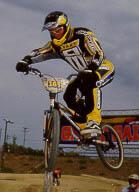 bmxultra.com:
You and Stu Thompson must have shared a few good memories, but what would
be the main motivation to reclass when you can still cut it In A pro?
bmxultra.com:
You and Stu Thompson must have shared a few good memories, but what would
be the main motivation to reclass when you can still cut it In A pro?
Harry: Well for one thing I would not have to put as much training time
in as I do, I might be able to ride my CR more! I don`t know, I guess
to race with no pressure might be a little more fun! But maybe that’s
what makes racing so much fun, is the pressure of not knowing the out
come of the race. I do not see myself moving out of the pro class, ever!
Racing pro is where it’s at! Ok, you convinced me!
bmxultra.com: Don’t let me convince you, it’s all about having fun right,
but how much fun is it to compete in a class with only one or two good
riders? Did you take some time off from BMX?
Harry: Your right about the competition thing, with out it what do you
have, basically you could just go for a ride in the park and get a better
work out than putting four or five half ass laps in at a race. That’s
why I really enjoy racing the A Pro class. The West Coast ABA Nationals
will have at least 7 gates of A Pros. So to just make the main is a good
day for me, that is cool. The A Pro class is super competitive these days.
Now we have the ABA Vet Pro class going again, which is good, but we only
have two gates. I am hoping that it will begin to grow and be a place
where old guys can race and have fun. Hey, you’re old, maybe if you come
to the US? As far as taking some real time off, I never really quit racing,
I always raced the ABA Winter Nationals and the Fall Nationals. It was
still part of my product development responsibilities while I was at Diamond
Back to be at the races. Riding and testing the stuff we were working
on for the following year was one of the fun things to do. When I started
at Balance I started training again and doing more riding at the tracks
working on the new line of Balance BMX bikes. Then Greg started working
at Answer products and he was making a go at the AA Pro class again (and
doing pretty good) so we would meet on our lunch hour and train along
with another guy from Answer Joey Licata. We did that for a couple years
or so, and that was about the time that the ABA started the Masters Pro
Class on 24" bikes. Which was a great way to go racing and have a good
time. Now I`m in my forth decade of racing BMX, who would have thought!
bmxultra.com: What effect do you think the web has had on BMX in general?
Harry: As for the web, I don’t think we have seen anything yet. It will
do more for how business is conducted than anything. I think we all need
to be more educated on the possibilities that the web has to over and
how we can best use it in a cost effective manner. The web has already
changed, it has gone from providing information for free to this E-commerce
nightmare. But there again things must evolve and improve. It’s tomorrow’s
business!
bmxultra.com: I see Dirtwerx doesn’t have a site, is it a fear of jumping
in the deep end?
Harry: Yes, that and just plain ignorance. But I have had a site in the
werx for some time, it seems that I am never happy with it so I have not
plugged it in. Just got to do it I guess
bmxultra.com: How many people are employed by Dirtwerx?
Harry: Two, we are very small still. I am trying to not over extend myself!
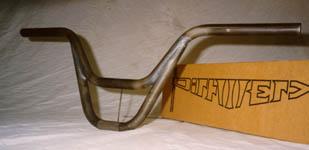 bmxultra.com: does Dirtwerx alone make enough money for you to get by on?
bmxultra.com: does Dirtwerx alone make enough money for you to get by on?
Harry: Well, I would have to say that Dirtwerx as a company is not yet
making me a pay check. I take what ever is left and put it back into promotions,
product, and team. It’s a long term plan, I hope!
bmxultra.com: do you run clinics?
Harry: I do some clinics but I mostly do private lessons. The tracks around
here are so cliniced out, and by doing privates I get the most dedicated
riders, I enjoy that part of teaching. I mostly work with kids on the
importance of consistant training, What to do, how to do it, how hard
to do it, that’s what gets riders going fast. Lots of people/kids wish
they could do better, but that’s just it, they keep on wishing. Nobody
wants to put out the effort. Matt Hadan is a perfect example, I don`t
think he really knew how hard he had to push himself to be the pro that
he is capable of being. We trained twice a week for about three months
towards the end of last year. That approach to training, has changed Matt.
He is now leading the ABA points, he is being called "the most consistant
pro this year". The best part is Matt did it, and Matt knows he did it.
Not me, not anybody else, Matt. If he sustains that output of effort,
he will be the #1 pro.
bmxultra.com: What are your favourite sites?
Harry: To be completely honest I really don’t have a favourite, I guess
if I had to choose it would be “RacerXonline”. I am really in to Motocross
right now, I race my “CR” on the weekends that I am not racing my BMX
bike. I just got moved up to expert, so now I know how all those kids
feel when they get moved up in BMX, its tuff. Motocross is the coolest
sport, tuff, but cool! Racer-X has the best magazine, so I go there all
the time for news and the latest info. I just found this sight called
“roost” it's all old school BMX. No Fear has a great sight, NacNac, is
cool. I enjoy reading the "Dog Crap" section in the S&M site. Chris has
always got something stupid and self-contradicting to say about nothing
and he likes going off on me. It's pretty funny that he gives me all the
free pub`s. You know what they say, "there is no bad press"...Press sells
bikes, thanks Chris!
bmxultra.com: Who would you like to thank throughout your lengthy racing
career?
Harry: Wow, God, Dad & Mom, Coats Schwinn, Jim Melton / JMC, Larry Baker
/ Larry`s Precission Welding, Bill Walters, Oakley, Rick Wilkinson, Gary
Cook, Stu Thompsen, Bob Haro, Dia-Compe, Araya Wheels, Aero Racing, Premier
Helmets, Ecko Helmets, Bell Helmets, Mike Bobrick / Diamond Back, Al Stonehouse,
Bill Imielski, Bob Arnold, Pete Sweany, MKS, Asahi, Sugino, Shimano, Rich
Long, Pete Collins, Clint Miller, Dennis Foster, Balance / Ben Hsia, Robin
Ho / Marvel Cycle, Answer Products, AXO Products, AME Grips, KnuckleBone,
Greg Hill, Matt Hadan, John Purse, The Arndt Family, Tony & Joan Nigro
/ Sycamore BMX, ABA, NBL, Bob Osborne, Gork, BMX plus / John Ker, Dave
House, my wife Elissa. I know I missed a lot of good people, sorry.

You can contact Harry for more details on Dirtwerx by emailing dirtwerx@aol.com
Interviewed: 03/06/00